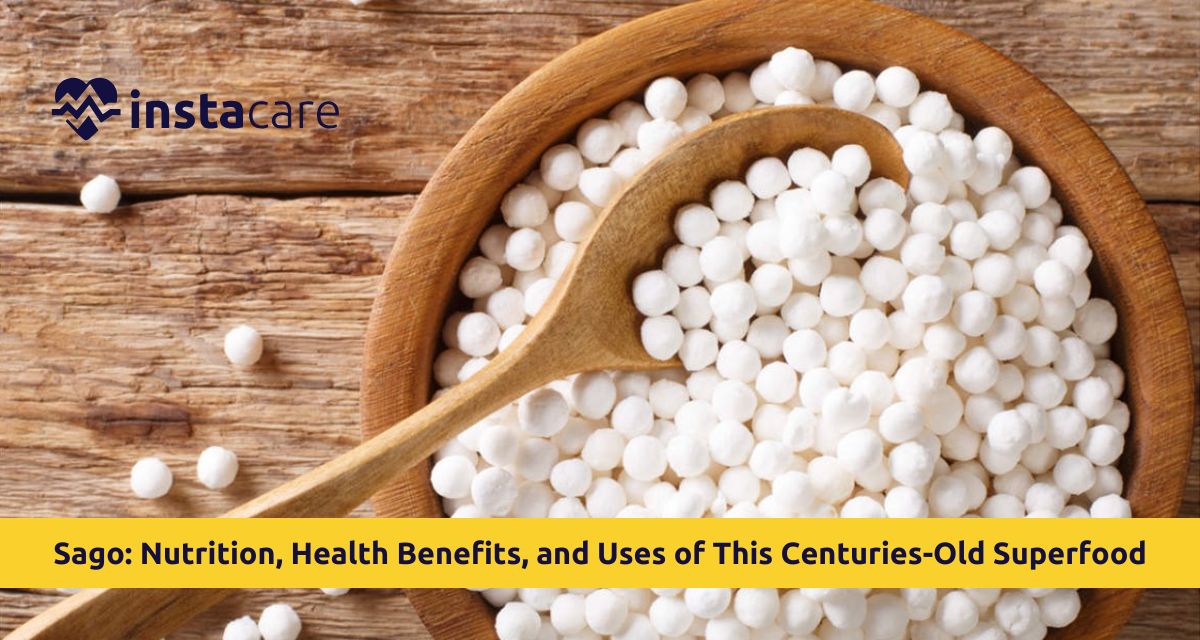To be familiar with the sago meaning is not only to be aware of its overall definition as a starchy food. This incredible ingredient is the product of years of indigenous food production skills, supporting life and possessing medicinal properties worthy even to contemporary nutrition.
What is Sago?
Sago is starch from the spongy center (pith) of trunks of several tropical palms, the most important of which is the sago palm (Metroxylon sagu). Sago is obtained by fell-cutting mature palms, splitting the trunk in two and removing the starchy pith, which is ground into flour or molded into pearls.
The most notable difference between sago vs tapioca is where the ingredient is sourced: sago is obtained from palm trees, whereas tapioca is derived from cassava root. Despite appearing identical and, likely, being able to be swapped out in a recipe for all intents and purposes, sago's texture and nutrition profile differ ever so slightly from tapioca's. Actual sago would be more fluid when cooked and contain an ingredient with no taste but which can absorb other tastes very well.
Sago occurs naturally without gluten, an excellent quality for people with gluten intolerance or
celiac disease. Such a quality merged with ease of digestibility has put sago on top of the most efficient therapeutic nutritional and special diet treatments.
Nutritional Profile of Sago
Sago composition is mostly carbohydrates with little protein, fat, and fiber. The following tabulation is of sago calories and nutrients in 100 grams dried sago:
Macronutrients:
- Calories: 355-360 kcal
- Carbohydrates: 88-94 grams
- Protein: 0.2-0.5 grams
- Fat: 0.2-0.5 grams
- Fiber: 0.9-1.5 grams
Micronutrients:
- Iron: 1.2-4.6 mg
- Calcium: 11-20 mg
- Phosphorus: 7-12 mg
- Potassium: 11-17 mg
- B vitamins present in trace amount
Although sago is not very nutrient-rich as opposed to unrefined cereals, the extensive content of carbohydrate stores energy instantly and can be useful in active individuals and convalescents.
Health Benefits of Sago
Energy Production and Athletic Performance
The most notable sago health benefits are quick release of energy. The concentrated carbohydrate composition offers immediate fuel for exercise and brain activity. Sago is eaten by athletes every day in pre-exercise foods to be able to maintain constant energy without creating gastrointestinal upset.
Support for Digestive Health
Sago's soothing action on the gastrointestinal tract makes it suitable for those with irritable stomachs, inflammatory bowel conditions, or convalescence from gastrointestinal disease. Its low fiber content means that it is easily absorbed without bloating or gas.
Weight Management Potential
Despite the caloric character of sago, sago for weight loss can be rendered beneficial through proper utilization. Due to the bulking character with smaller quantity, the overall caloric intake can be controlled. Nontasteful in character, the time gap to create new low-calorie preparations to suppress hunger pangs without consuming extra calories is useful.
Gluten-Free Alternative
It can be used as a replacement for nature in the form of gluten-free sago, with diversification in carbohydrates to individuals that have dietary restrictions against gluten. Sago can be baked, cooked, or employed as a thickener without transgressing dietary limits.
Traditional Therapeutic Uses
Sago in Ayurveda has been made cold and easily digestible and is hence used routinely in cases of fever, debility, or gastric irritability. Traditional medical systems appreciate the aspect of sago being nutritious without much additional burden on the digestive system.
Culinary Usage of Sago
Breakfast Options
The most frequent preparation is sago porridge that is commonly boiled in milk or coconut milk or honey and jaggery for sweetness. The smooth, comforting dish gives slow energy in the morning and can be seasoned with nuts, fruits, or spices.
Desserts and Sweets
The most popular dessert use is sago pudding. The pearls gelatinize and become translucent when cooked, adding distinct textures to puddings, kheer, and bubble tea beverages. Popular sago recipes include:
- Sago payasam with coconut milk and cardamom
- Fruit sago pudding with tropical fruits
- Sago laddu (sweet balls) with nuts and dates
- Rose water cold sago desserts
Savory Applications
In addition to sweets, sago uses are found in savory environments:
- Sago vada (fry fritters) on fasting days
- Sago upma for breakfast
- Thickening clear soups
- Fried food coating
Baby Food
Baby food from sago for babies is commonly advised as a first solid food because it is a light food and easily digestible. It is served as a thin gruel and gives the body strength without subjecting an infant's still immature digestive system to pressure.
Fasting Foods
Sago during fasting is optimally savored in Hindu cultures, where it is religiously permitted on days of fasting but not for cereals. It is flavorless and satiating and therefore assists in maintaining consistent energy levels in extensive fasting.
Possible Side Effects & Precautions
Digestive Considerations
- Possible sago side effects include:
- Bloating or fullness due to the starch
- Constipation in certain persons, especially if water intake is suboptimal
- Blood glucose is elevated in diabetics because of elevated glycemic index
Allergic Reactions
Though uncommon, allergic reactions against sago are seen in allergy patients to palm. Skin rash, gastrointestinal illness, or respiratory illness are some of the effects that can be attained. Commercially consumed processed sago food may include additives or have come from a factory that also processes allergens. Seek high-quality brands and do not watch for labels for potential cross-contamination.
Nutritional Constraints
Sago's narrow micronutrient content ensures it cannot be substituted by healthier whole grains at any cost. It should be used to maximum effectiveness as part of a diverse diet and not as a significant source of carbohydrates.
Conclusion
Sago is a tribute to the gastronomic wisdom of the past, providing the modern consumer with a practical, gluten-free carbo hydrate food whose gastronomic value cannot be beat. While it's not exactly a nutritional giant when measured in terms of vitamin and mineral content, its digestibility, energy-generating value, and cultural cachet are reasons nutritional and gastronomic investigation merits exploration.
If you are looking for substitutes to gluten intolerance, hoping to combine sources of carbohydrates, or simply to try out traditional foods, then sago is a likely contender. With a mild flavor and interesting texture, there are the possibilities for traditional and classic applications, as well as innovative new applications.
Like all that you eat, variety and moderation are the key. Sago must be maximized in the balanced diet through a blend of nutrients so that you can derive the benefit without lowering your nutritional level.
Please book an appointment with the
best Nutritionist in Lahore, Karachi, Islamabad, and all major cities of Pakistan through
InstaCare, or call our helpline at 03171777509 to find the verified doctor for your disease.

